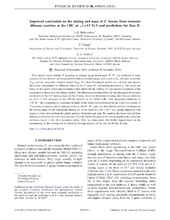Improved constraints on the mixing and mass of Z ′ bosons from resonant diboson searches at the LHC at √ s = 13 TeV and predictions for Run II
Peer reviewed, Journal article
Published version

Åpne
Permanent lenke
https://hdl.handle.net/1956/23321Utgivelsesdato
2018Metadata
Vis full innførselSamlinger
Originalversjon
https://doi.org/10.1103/physrevd.98.095029Sammendrag
New neutral vector bosons Z ′ decaying to charged gauge boson pairs W + W − are predicted in many scenarios of new physics, including models with an extended gauge sector such as E 6 , left-right symmetric Z ′ LRS and the sequential standard model Z ′ SSM . For these benchmark models we calculate and present theoretical expectations for different values of the Z ′ mass M 2 and mixing parameter ξ . Our results are based on the narrow width approximation which allows for the making of a convenient comparison of the experiment to theoretical benchmark models. The diboson production allows for the placement of stringent constraints on the Z − Z ′ mixing angle and the Z ′ mass, which we determine by using data from p p collisions at √ s = 13 TeV recorded by the ATLAS detector at the CERN LHC, with integrated luminosity of ∼ 36 fb − 1. By comparing the experimental limits to the theoretical predictions for the total cross section of Z ′ resonant production and its subsequent decay into W + W − pairs, we show that the derived constraints on the mixing angle for the benchmark models are of the order of a few × 10 − 4 , i.e., greatly improved with respect to those derived from the global analysis of electroweak data. We combine the limits derived from diboson production data with those obtained from the Drell–Yan process in order to significantly extend the exclusion region in the M 2 − ξ parameter plane. Also, we demonstrate that further improvement on the constraining of this mixing can be achieved through analysis of the full set of Run II data.
